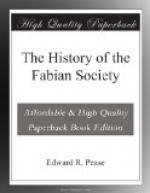However, for once we took up an already popular proposal. The Housing of the Working Classes Act of 1890 was an admirable measure, but it was hedged about with obstacles which rendered it very difficult to work in urban areas and virtually useless in rural districts. We had drafted an amending Bill for rural districts in 1895, which was read a first time in the House of Commons on the day of the vote on the supply of cordite, when the defeat of the Liberal Government led to the dissolution of Parliament.
The Act of 1890 was singular in one respect. Part III was headed “Working-Class Lodging Houses,” and was drafted accordingly, but the definition of lodging-houses was made to include cottages with not more than half an acre of garden, thus enabling houses to be provided by local authorities in town and country, apart from clearances of insanitary areas. For years this definition was overlooked, and very few people were aware that cottages could be built in rural districts by the Guardians, and later by Rural District Councils. Our Leaflet No. 63, “Parish Council Cottages,” issued in 1895, was almost the first publication drawing attention to the subject, and with one exception no use was made of these powers of the Act in rural districts before that year. Our Tract 76, “Houses for the People,” published in 1897, explained the Act in simple language, and was widely circulated.
In 1900 an amending Act, chiefly to simplify procedure in rural districts, was promised by the Government; and the conference we called was intended to agitate for widening its scope and strengthening its provisions. The papers, read by Clement Edwards (afterwards M.P.), Miss Constance Cochrane, Alderman Thompson, and others, were first discussed at a preliminary private meeting in December, and then submitted to the Conference, which was held on March 1st, the day following the Conference at which the Labour Party was established. By choosing this date we secured a large number of delegates from Trade Unions, and these were reinforced by numerous delegates from Vestries and other local authorities, altogether numbering about 400. At the close of the proceedings a National Committee was formed with headquarters at the Fabian Office, which had however only a short career. The Conference papers were printed as a bulky penny tract, “The House Famine and How to Relieve It,” which rapidly went through two editions. We also published “Cottage Plans and Common Sense,” by Raymond Unwin, which describes how cottages should be built—an anticipation of garden suburbs and town-planning—and a compilation of everything which Parish Councils had done and could do, including housing, prepared by Sidney Webb and called “Five Years’ Fruits of the Parish Councils Act,” which in 1908 was revised and reissued as “Parish Councils and Village Life.” A speech by W.C. Steadman, M.P., who was a member of the Society, was printed under the title “Overcrowding and Its Remedy.” Our agitation was not without results. The amending Acts of 1900, 1903, and 1909 have done much to remove the unnecessary administrative complexities of the Act of 1890, but in fact the problem is still unsolved, and the scandalous character of our housing, both urban and rural, remains perhaps the blackest blot in the record of British civilisation.




